Packs, Barrels and Wanigans for Paddling the Far North
There are numerous ways to organize and pack for a far north canoe trip. My system employs a daypack for items I want to access in the canoe, and tent pack and an annex pack that I share with my partner. I portage the tent pack up to the camping area and leave the annex pack at the canoe.

Gear for a far north trip sits on the tarmac. Expect to pay overage fees on baggage.
For food, I use traditional food packs (by Cooke Custom Sewing) along with a barrel for bread and crackers and a wanigan for kitchen gear. For my personal gear, I prefer a waterproof roll-down canoe pack (Cascade Designs Sealine Pro Pack). The way you choose to pack will be up to you—some of the equipment I consider group gear, you may consider personal gear.
The Daypack
This pack serves as a place to store miscellaneous items as well as important gear essential or handy to have on hand. Any daypack will work. I prefer a simple, frameless pack with a single main compartment. It is easy to convert into a waterproof pack with a 20L dry bag and small enough to easily stuff into the canoe—in the bow or elsewhere in the boat. It’s also light enough to toss on top of another pack while portaging. You can also find several waterproof daypacks on the market.
I pack the following in my daypack (just don’t overdue it—stuff a daypack to the brim and you do not have quick and easy access to its contents):
- Water bottle—500 ml or 1 L
- Binoculars—I like waterproof Pentax
- Toilet paper, wind proof lighter, soap or hand sanitizer
- Trowel—make sure it is sturdy; the tundra can be tough.
- Toiletries in a ziplock bag—toothbrush, toothpaste, dental floss, hairbrush, hand lotion. I often pack my tent/personal pack before breakfast; this keeps toiletries accessible.
- Rain jacket and pants
- Camera—batteries and memory cards
- Micro cloth—for cleaning the camera lens and eyeglasses
- Mini-tripod—for group photographs or shooting video
- Whistle
- Hats and gloves—see personal gear and clothing
- Compass—by not keeping the compass in the map case it never gets in the way of reading the map.
- Business cards, notebook and pencil—for meeting other canoe trippers, jotting down information, etc.
As the day warms up, I also stuff extra layers in my daypack when I’m not wearing them. Some paddlers wear a waist, bum, or fanny pack to store small items and alleviate the need to find and remove the daypack. Contents could include sunscreen, sunglasses, reading glasses, and emergency gear.
Food and Equipment Packs
Traditional Canoe Packs

Double packing traditional canoe packs.
These packs have been around for a long time for a good reason—they work. With a pack liner, traditional canoe packs become waterproof. Pack liners can be as simple as a large plastic bag (Duluth Pack Poly Pack Liners) or specially made waterproof roll-down pack liners (Ostrom Pack Liner). There are modern versions of traditional canoe packs (see Cooke Custom Sewing, Ostrom, and Trailhead).
Waterproof Roll-down Closure Packs
These are similar to traditional canoe packs but made of a single layer of waterproof material. If packed right, they are comfortable to portage and waterproof. The material is durable but a puncture results in loss of waterproofness unless repaired. They do not absorb water and therefore do not gain weight when wet. Examples include Cascade Designs Sealine Pro Pack, and Eureka.
Barrels
Often called blue barrels because the most common color is blue. Their advantage is the quick and easy waterproof lid and rodent proof system. The barrel is odor proof and does not absorb water or gain weight when wet.
Two common sizes are the big barrel (60 L) and the small barrel (30 L). The big barrel has a large enough opening to get just about anything into it. The small barrel opening may restrict a large pot but otherwise allows most items to be packed. The small barrel doubles as a campstool.
A pair of large barrels lie down either longitudinal or crossways in most tripping canoes. If secured they provide floatation. If a canoe upsets, the barrels float and the blue color is easy to spot.

A barrel’s bright blue color makes it easy to spot in the Arctic.
Most paddlers purchase a harness system for portaging:
- Headstrong harness
- Ostrom Outdoors Deluxe barrel harness
- Backboard system—similar to an external frame pack without the pack. Tie or strap the barrel to the backboard
It can be challenging to make the rounded surface comfortable against your back. Also, when packing the barrels, it is best to pack soft food or clothing instead of hard or rectangular shaped items.
Remember that even the large barrel at 60 L is substantially smaller than a big 110 L canoe pack. This could be a concern during a long trip. Short canoe packs stand up right in a canoe and will yield more storage than barrels.

Filling the bailer with treats helps keep you going when the going gets tough.
Wanigans
Wanigans, the traditional grub-box for canoe tripping, are often hand made or purchased from a cottage industry. They are still a tradition of summer camps and are portaged via a tumpline. Wanigans help organize kitchen and cooking gear but some trippers consider the box itself unnecessary weight. I believe wanigans become efficient when travelling with six people.
Next: Tents, Tarps, and Shelters
 Brian Johnston, Editor of the Paddle Canada Canoe Program. Brian has paddled Far North rivers of all kinds: swift descents from the mountains into the Mackenzie Valley, subarctic rivers emptying into the Arctic Ocean, traverses from the Northwest Territories to Nunavut, and drainages into Hudson Bay.
Brian Johnston, Editor of the Paddle Canada Canoe Program. Brian has paddled Far North rivers of all kinds: swift descents from the mountains into the Mackenzie Valley, subarctic rivers emptying into the Arctic Ocean, traverses from the Northwest Territories to Nunavut, and drainages into Hudson Bay.









